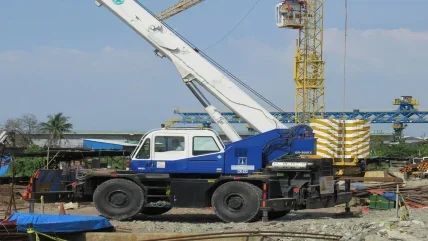
How has the last year of business been for cranes been in the domestic market?
In Japan, demand remained strong on the back of steady crane operations hours, particularly for large-scale public works projects.
What have been the main reasons and drivers behind this?
There was an increase in large public works projects and strong rebound demand after Covid-19.
What is your most popular crane line for the Japanese and Asia Pacific market?
In Japan it’s the GR-250N-5 rough terrain line and in the APAC region it’s the GR-500EXL-3 and GR-1000EX-4 rough terrain crane lines.
Why are these lines, in particular, proving so popular?
For the GR-250N-5, in Japan, rough terrain cranes are allowed on public roads. However, their driving is subject to numerous regulations. The GR-250N-5 is the most efficient vehicle size and lifting capacity for Japanese roads and working conditions.
For the GR-1000EX-4, well, this model features our new Smart Chart and Smart Counterweight technologies. These systems improve lifting capacity and extend reach. These new systems can be adapted to a wide variety of work sites.
The GR-500EXL-3 is proving so popular because the customer can choose between left-hand and right-hand drive, depending on the regulations in each country. Driving performance is also enhanced, making it possible to cover longer distances.
What are the main challenges you face in the home market?
Demand for cranes in the Japanese market may decline in the future due to demographic trends. To counter this, however, we are accelerating our overseas expansion while maintaining the scale of sales in Japan.
How exactly are you planning to maintain strong sales in Japan?
By increasing the added value of cranes in the mature Japanese market, they will be valued and appreciated by customers, and will be redirected towards overseas development. In this context, we will focus particularly on the development of environmentally friendly products.
Are there any exciting new application areas you are seeing your cranes being used for?
Construction of offshore wind farms has begun in Japan, and our cranes are now in demand for these projects.
How strong is the demand for electric cranes in Japan?
We have received many requests from large general contractors and other companies all looking to decarbonise their jobsites.
Is the forthcoming release of the GR 250N Evolt a kind of ‘trial run’ for the wider launch of the larger GR 1000XL L Evolt or are there also plans for a global launch of the GR 250N?
First, the EVOLT eGR-250N* crane will be launched in Japan at the end of 2023, and the EVOLT GR-1000XLL (working name) is scheduled for launch in the USA and Canada in 2024. As far as global compatibility is concerned, Tadano is currently researching regulations and charging systems in each country. *(The lower-case “e” in front of the model name indicates the EVOLT series.)
MANUFACTURING PROCESS… Tell us about your manufacturing process? Are your cranes produced by hand-welding or robots? What are the advantages of your approach?
In Japan, our cranes are manufactured both by manual welding and by robots. The factory is close to the sea, which is an advantage for the shipping process. See our YouTube video: www.youtube.com/ watch?v=bcBN9IwaQuI
How many crane manufacturing facilities do you have in Japan? Where exactly are they located?
We currently have four crane manufacturing plants in Japan: Shido, Kozai, Tadotsu in Kagawa Prefecture and Chiba in Chiba Prefecture.
How important to Tadano are your research and development activities?
The development of a new crane model involves a thorough market survey to determine needs, and every step from design to testing to mass production. The process takes several years from research to the start of development. In addition, the company has established technical research centres in Japan and Europe, where we conduct research (not only on cranes) on a daily basis.
APPLICATION AREAS AND THE FUTURE…
Are there any new application areas underpinning crane sales in Japan and the wider Asia Pacific region? If so, what type of work and what cranes are in demand?
Both Japan and APAC are accelerating onshore and offshore wind power projects, and we believe that large crawler cranes and all terrain cranes will be needed for their construction.
And what are your primary aims for future development?
The Tadano Group has adopted the message “Our True Mission: Zero Emissions” with the aim of achieving carbon net zero in 2050 and reducing CO2 emissions in its business activities by 25% and in its products by 35% by 2030.
How exactly do you plan to achieve this?
We will continue to deliver products that satisfy all environmental aspects, ease of use, and efficiency as “Tadano Green Solutions”. We are committed to leading the way in environmental responsiveness in preparation for future changes in construction sites.
EVOLT is the name of a series of fully electric products, and the rough terrain cranes announced this time are the first in the series






